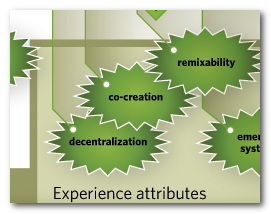 A while ago I was asked to help answer an interesting question. Imagine: you want your website (and organisatuon) to become “truly web 2.0”, and a donor is considering a sizeable grant to help you do that, under the condition that you define yourself how you will measure your “web 2.0”-ness, set your own targets for the next half year, and have reached those targets by then. What would you measure and what targets would you set?
A while ago I was asked to help answer an interesting question. Imagine: you want your website (and organisatuon) to become “truly web 2.0”, and a donor is considering a sizeable grant to help you do that, under the condition that you define yourself how you will measure your “web 2.0”-ness, set your own targets for the next half year, and have reached those targets by then. What would you measure and what targets would you set?
- Indicators: Web 1.0 metrics like number of visitors or registered users are not really a measure for “web 2.0-ness”. Amount of user-generated content maybe more. Per registered user? Number of mashups? Position in Technorati? Having an API, connecting to the APIs of other sites? Number of feeds into your site?
- Targets: A 6-month timeframe to do the technical work and show measurable results would lead me to focus more on the infrastructure and organisational side of things. What’s a realistic target… needs to be compelling enough to get the grant, but also a pretty certain win…
I tapped into the wealth of wisdom in the Web of Change crowd. Marty Avery send me an interesting link to “Experience Attributes: Crucial DNA of Web 2.0”, an essay by Brandon Schauer of Adaptive Path. “Quite old” by web 2.0 standards (written December 2005), but very relevant to help guide our thinking and provide a bit of authority. Brandon distinguishes two sets of attributes, that together make up “web 2.0 DNA”:
- Foundation attributes: user-contributed value, the long tail, network effects. In Brandon’s words: “They enable Web 2.0 offerings to generate and maximize value from many sources, no matter how small they may be.”
- Experience attributes: de-centralization, co-creation, remixability, and emergent systems. Again, in Brandon’s words: “By blurring the lines that traditionally delineate supplier, vendor, and customer, these services have pioneered new value streams that can output new types of offerings, harness new efficiencies, and produce higher levels of continuous innovation.”
A quick analysis showed that the focus should indeed be on these experience attributes: the foundations were there, the basic system and processes work, things are happening. But they need to accelerate, explode, go viral. It still wasn’t hard to distinguish supplier, vendor, and customer in the current setup. We all could see new ways to offer new types of value to all stakeholders, but it was time to deliver, and the experience attributes nicely mapped onto dreams, visions, and ideas to move forward.
So with all the technical development just starting, and only some five months left to show concrete, measurable results, targets were mainly defined in terms of those experience attributes:
- Get at least a couple of formalised partnerships to decentralize and scale up major parts of the organisational processes.
- Get content in from a few dozen external sources, to remix with the user-generated content already there.
- Provide new website tools to transform all of that content into compelling stories.
- Provide new ways for people to share their experiences with their peers and promote the platform, and see them use those.
- Double the overall amount of page views this way (ay, is this a web 1.0 metric slipping in after all?)
Ambitious goals, but more important: not just hoping on technical wizz-bang to solve things. Developing partnerships and compelling stories is far more a process and collaboration issue (and by far not easy to accomplish in half a year either, but work was already further on the way here). And if nothing else, burning some cash on advertising will provide a reasonably predictable growth of page views if needed — although I’m not supposed to take such a cynical view on these things (yet).
